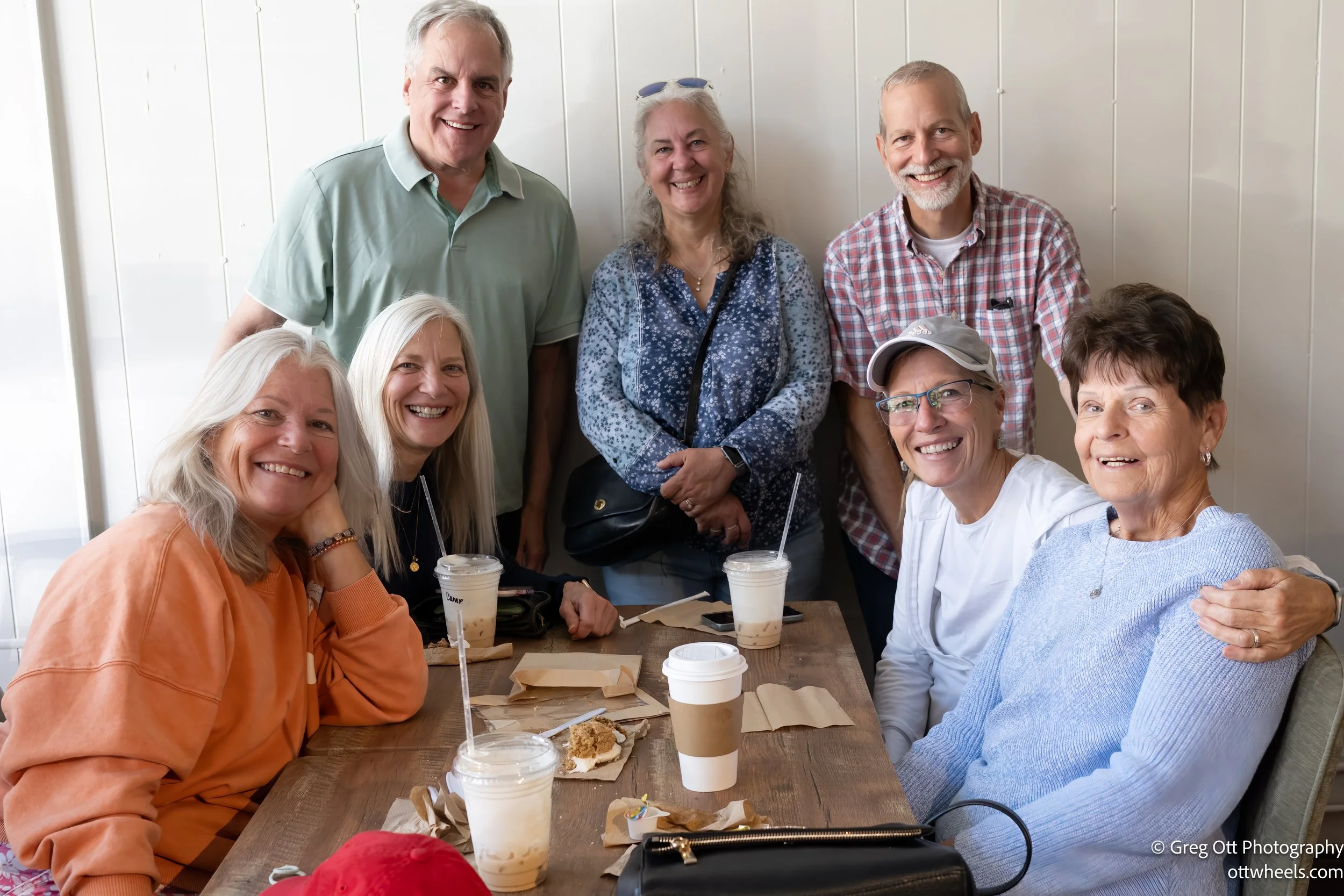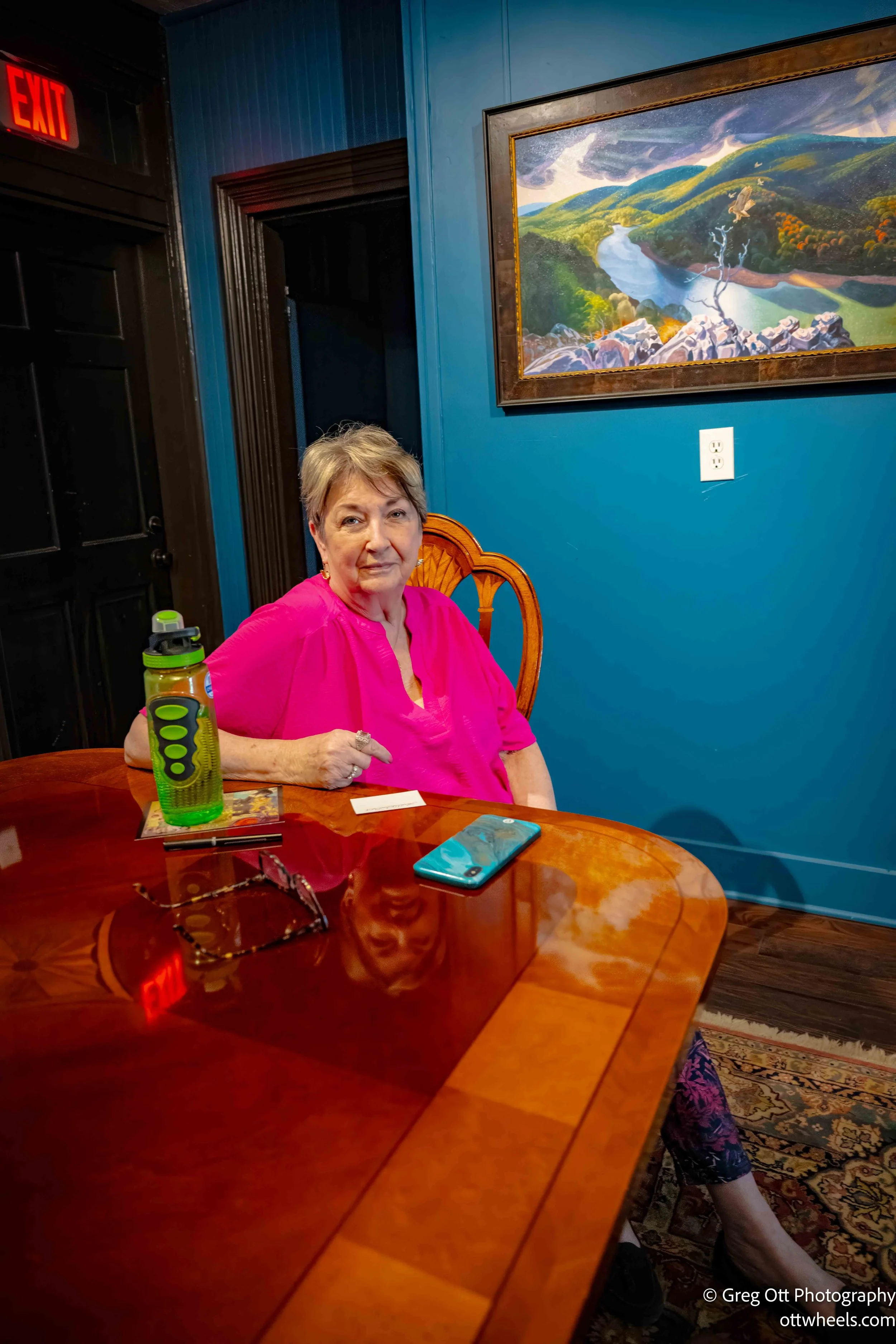Ste. Genevieve, MO
Ste. Genevieve is one of those places where history doesn’t just sit behind museum glass—it still breathes in the streets, the people, and the land itself. I began my visit at the Welcome Center, where the woman at the desk shared a lot of helpful information. The Ste. Genevieve National Park Service section of the center wasn’t staffed that day, but the city still operates the other half. I picked up several NPS brochures—they’re always so well done—and I spent a few minutes studying the model of the town, which really helped put everything into perspective.
Welcome Center Town Layout
The woman at the Welcome Center told me where to find the local coffee shops, and Birdies on Main sounded like just what I was looking for. There were only three people in line ahead of me, but it wasn’t moving very fast. At a nearby table, a group was chatting and laughing—part of a family reunion, as it turned out. One of the women called out, “Take our picture!” So I did. They told me they’d come from all over for the reunion, and someone joked, “Do you want to join us?” I smiled and declined, not sure if she was serious. Later, I sent them the photo but never heard back.
The town began as part of “Le Grand Champ,” the great agricultural plain that stretched along the Mississippi River. Early French settlers used the rich bottomlands for farming, growing wheat, corn, and tobacco. Their homes, built in the poteaux-sur-sol style (posts-on-sill), still stand as a testament to their craftsmanship and resilience. Names like Jean Baptiste Vallé still echo through the town—he was one of the last French commandants of the region before it became American territory. Standing in front of the Bauvais-Amoureux House and the Green Tree Tavern, I could almost imagine what it must have been like in the 1700s, when the French, Spanish, and later Americans all left their imprint here.
The Louisiana Purchase changed everything for Ste. Genevieve. Overnight, this small French village found itself part of a new nation that spoke a different language and had a very different way of life. In just a few days, three flags—French, Spanish, and American—flew over the town as control changed hands. It’s one of those moments in history that feels almost cinematic: people waking up under one government, going to bed under another, and rising the next morning as citizens of an entirely new country. Yet through it all, Ste. Genevieve managed to hold on to its French soul. The rhythm of life remained slower, more communal, and deeply tied to the land and river that sustained it.
I toured the Hands-On House with a small group. I met a mother, her daughter, working in the back—and we had a lovely conversation about traveling throughout the world.
Just across the street behind the Bolduc House, a group of reenactors were living as frontier settlers for the weekend. They slept in canvas tents, cooked over open fires, and spent the day interacting with visitors. It was easy to get caught up in their stories of survival and community.
Nearby, the gardens were a mix of European and Indigenous plants—showing the blend of cultures that defined this place. I took my time there, photographing bees and butterflies hovering over the flowers.
Following the map of historic attractions, I wandered through town and stumbled upon a park where a single fifth-wheel camper sat. I asked how to book a site, but the directions led me to a restaurant that was closed. The Welcome Center gave instructions to another place, but no one was there either. After a few failed online searches, I gave up and decided to enjoy lunch instead. The Old Brick House—said to be the first brick building west of the Mississippi—was my stop. The meal was simple pub fare, nothing memorable, but sitting in that centuries-old building made up for it. There’s something about eating where generations have gathered that makes even an average meal feel like part of a larger story.
After lunch, I found Sara’s at 124 Merchant Street. It’s a family-run place with an old-fashioned soda fountain charm. The owners bought the building in December 2024, renovated it, and opened in May 2025. Inside, the owner’s son and daughter worked behind the counter, serving ice cream and chatting with customers. The ice cream itself was from Wisconsin, sold only to ice cream shops, and while it wasn’t made in-house, it was creamy and rich. Their warmth and enthusiasm were the real treat.
Ste. Genevieve has a rich artistic spirit that runs as deep as its history. I passed signs for the Art Colony and several galleries scattered throughout the old town streets. A few storefronts doubled as working artist studios, where you could peek through open doors and catch glimpses of canvases mid-stroke or pottery still drying on the wheel. It felt like the town itself had become a living gallery—every building, garden, and street corner infused with creative energy. The blend of old French architecture and modern artistry gave Ste. Genevieve a unique rhythm, where history and imagination seemed to coexist in perfect harmony.
My next stop was the Two Rivers Gallery. From the sidewalk, I saw a few paintings through the window—bright, detailed, and unmistakably local—and couldn’t resist stepping inside. The gallery was calm and filled with light, every wall lined with the work of Missouri artist Bryan Haynes. His paintings captured the soul of the Midwest: rolling hills, quiet rivers, and people in motion, grounded in place yet full of life. I spent about forty-five minutes studying the brushwork and admiring the color, completely absorbed in the atmosphere.
While I was there, I met Lavetta Rhinehart, who was watching over the gallery. We struck up a conversation that quickly moved from art to travel to life itself. Lavetta told me about her late husband, M. Charles Rhinehart, also a well-known Missouri artist, and about her own recent work sculpting in brass. She spoke with the kind of wisdom that comes from a lifetime of creating—about patience, process, and the joy of seeing form emerge from raw material. She had an easy presence, both grounded and curious, and it was one of those unexpected encounters that stays with you.
Artist: Lavetta Rhinehart
When I finally stepped back outside, I realized how much this small town celebrates creativity—not just in its galleries, but in the way people share their stories. Talking with Lavetta reminded me that art and travel are deeply connected; both invite you to slow down, to look closer, and to find meaning in the details.
As evening settled in, I took one last walk through town. Most of the shops were closing, and I didn’t want to leave. The historic homes glowed softly in the late light, as if they, too, were reluctant to call it a day. Back at the van, the host at the Welcome Center was locking up for the night. I spent about half an hour researching where to stay closer to St. Louis and found a Cracker Barrel in Herculaneum, about forty-five minutes away. I arrived after six, parked for the night, and soon realized the nearby Federated Auto Parts Raceway at I-55 was in full swing. The time trials roared every few minutes—two-minute bursts of noise that shook the air. I stayed in the van, waiting it out.
I had a salad at Cracker Barrel and then went back to the van. Eventually, around eleven, the engines went silent and the world settled down again. Lying there, earbuds in, I thought about the people I’d met and the stories I’d heard in Ste. Genevieve. For a town so small, it held more layers of history—and humanity—than many big cities ever will.
























